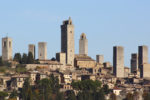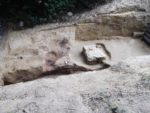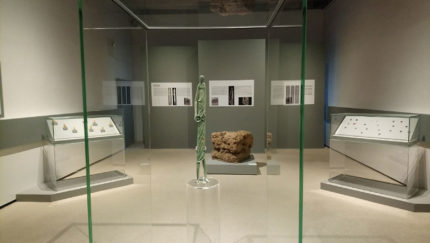 The Tuscan hill town of San Gimignano is famed for its stunning array of medieval towers. While only 14 of the 72 tower houses built by competing noble families as symbols of their wealth and military strength survive today, they make an indelible mark on the town and preserve the medieval architectural character which has been lost in the larger, more developed cities like Florence and Siena. Today zoning regulations prohibit the alteration of historic buildings and spaces, keeping the center of the town’s medieval layout — from streets to squares to structures — remarkably intact.
The Tuscan hill town of San Gimignano is famed for its stunning array of medieval towers. While only 14 of the 72 tower houses built by competing noble families as symbols of their wealth and military strength survive today, they make an indelible mark on the town and preserve the medieval architectural character which has been lost in the larger, more developed cities like Florence and Siena. Today zoning regulations prohibit the alteration of historic buildings and spaces, keeping the center of the town’s medieval layout — from streets to squares to structures — remarkably intact.
But the town itself long pre-dates the era that has come to characterize it. A new exhibition at the Archaeological Museum of San Gimignano turns the spotlight on the town’s ancient history, and it features a never-before-seen artifact from its Etruscan past: a dramatically elongated Hellenistic statuette of a magistrate making an offering. The figurine was discovered in  2010 during construction work on private property on the hillside that leads from San Gimignano to the Elsa river valley. Crews carrying out the digging work first noticed traces of bright green, then saw a long, flatish piece of bronze. That green rectangle turned out to be a bronze figure of a man placed face-down in prone position.
2010 during construction work on private property on the hillside that leads from San Gimignano to the Elsa river valley. Crews carrying out the digging work first noticed traces of bright green, then saw a long, flatish piece of bronze. That green rectangle turned out to be a bronze figure of a man placed face-down in prone position.
The renovation ceased while regional authorities organized an excavation which revealed an extraordinary Etruscan open-air sacred space in active use from the 3rd century B.C. until the 2nd century A.D. The figurine was  buried next a large stone square monolith that served as an altar for religious rites. There are extant traces of fire on the stone from burned offerings. Archaeologists recovered coins, ceramic fragments and unguentaria. The sacred area was next to a spring, so might have been dedicated to a water/earth deity.
buried next a large stone square monolith that served as an altar for religious rites. There are extant traces of fire on the stone from burned offerings. Archaeologists recovered coins, ceramic fragments and unguentaria. The sacred area was next to a spring, so might have been dedicated to a water/earth deity.
![]() The statuette, remarkably intact in virtually pristine condition, depicts a highly stylized elongated figure dressed in a toga draped over one shoulder, his right arm, chest and torso exposed, reaching below his knee. He is shod in flat-soled calcei booties with laces crossed over his feet and around his ankles and lower shins. In his right hand he holds a phiale mesomphalos (a libation vessel with a bump in the middle because the underside has a hollow you put your finger in to steady the flat plate when pouring out liquid offerings). His left hand, attached to his body, is turned palm-out. His facial features are finely detailed, his hair combed forward, his eyes large, his lips full over a pronounced chin dimple. The toga over bare chest, shoes, his posture and the phiale identify him as a magistrate engaged in a ritual offering.
The statuette, remarkably intact in virtually pristine condition, depicts a highly stylized elongated figure dressed in a toga draped over one shoulder, his right arm, chest and torso exposed, reaching below his knee. He is shod in flat-soled calcei booties with laces crossed over his feet and around his ankles and lower shins. In his right hand he holds a phiale mesomphalos (a libation vessel with a bump in the middle because the underside has a hollow you put your finger in to steady the flat plate when pouring out liquid offerings). His left hand, attached to his body, is turned palm-out. His facial features are finely detailed, his hair combed forward, his eyes large, his lips full over a pronounced chin dimple. The toga over bare chest, shoes, his posture and the phiale identify him as a magistrate engaged in a ritual offering.
![]() It is an Etruscan votive figurine which can be dated from its stylistic elements to the middle of the 3rd century B.C., made by the artisans of neighboring Volterra who were renown for the bronze casting skills. A piece in this style found in Volterra in the 18th century was dubbed the “Shadow of the Evening” because of his loooong stretched out body and normal sized head. This figure has been yclept the Shadow of San Gimignano, or the Offeror. Elongated Etruscan bronze statuettes are rare, and at more than two feet tall and weighing almost five pounds, the Shadow of San Gimignano is an exceptional example, larger, heavier and more detailed than comparable works. It is also the only one excavated from a sacred context.
It is an Etruscan votive figurine which can be dated from its stylistic elements to the middle of the 3rd century B.C., made by the artisans of neighboring Volterra who were renown for the bronze casting skills. A piece in this style found in Volterra in the 18th century was dubbed the “Shadow of the Evening” because of his loooong stretched out body and normal sized head. This figure has been yclept the Shadow of San Gimignano, or the Offeror. Elongated Etruscan bronze statuettes are rare, and at more than two feet tall and weighing almost five pounds, the Shadow of San Gimignano is an exceptional example, larger, heavier and more detailed than comparable works. It is also the only one excavated from a sacred context.
Almost 10 years after its discovery, the Shadow of San Gimignano has gone on public display for the first time. Hinthial: The Shadow of San Gimignano opened last month and will run through May 31, 2020. Hinthial means sacred or soul in Etruscan, and the exhibition is structured as an immersive voyage through an Etruscan/Roman sacred landscape with the Offeror as its culmination.
